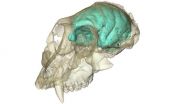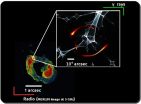(Press-News.org) This news release is available in German.
The oldest known Old World monkey, Victoriapithecus, first made headlines in 1997 when its fossilized skull was discovered on an island in Kenya's Lake Victoria, where it lived 15 million years ago. An international team led by Fred Spoor of the Max Planck Institute for Evolutionary Anthropology in Leipzig, Germany, and University College London (UCL), UK, has now visualized this monkey's brain for the first time: The creature's tiny but remarkably wrinkled brain supports the idea that brain complexity can evolve before brain size in the primate family tree. Especially surprising was the size of the monkey's olfactory bulb: It was three times larger in Victoriapithecus than in present-day monkeys of comparable body size.
Fred Spoor and co-author Lauren Gonzales of Duke University in Durham, USA, created a three-dimensional computer model of the animal's brain and calculated its brain volume to be about 36 cubic centimeters, which is less than half the volume of monkeys of the same body size living today. If similar-sized monkeys have brains the size of oranges, the brain of this particular male was more akin to a plum.
"When Lauren Gonzalez finished analyzing the scans she called me and said, 'You won't believe what the brain looks like,'" says co-author Brenda Benefit of New Mexico State University, who first discovered the skull with NMSU co-author Monte McCrossin. "This study shows the power of modern digital imaging methods to get essential information out of precious fossils that would otherwise remain unknown", says Fred Spoor, an expert in studying fossils with computed tomography and 3D visualization.
Despite its puny proportions, the animal's brain was surprisingly complex. The CT scans revealed numerous distinctive wrinkles and folds, and the olfactory bulb - the part of the brain used to perceive and analyze smells - was three times larger than expected. "Victoriapithecus probably had a better sense of smell than many monkeys and apes living today," Gonzales explains. "In living higher primates you find the opposite: the brain is very big, and the olfactory bulb is very small, presumably because as their vision got better their sense of smell got worse. But instead of a tradeoff between smell and sight, Victoriapithecus might have retained both capabilities," Gonzales says.
The findings offer new clues to how primate brains changed over time, and during a period from which there are very few fossils. "This is the oldest skull researchers have found for Old World monkeys, so it's one of the only clues we have to their early brain evolution," adds Benefit.
In the absence of fossil evidence, previous researchers have disagreed over whether primate brains got bigger first, and then more folded and complex, or vice versa. "In the part of the primate family tree that includes apes and humans, the thinking is that brains got bigger and then they get more folded and complex," Gonzales says. "But this study is some of the hardest proof that in monkeys, the order of events was reversed - complexity came first and bigger brains came later."
The findings also lend support to claims that the small brain of the human ancestor Homo floresiensis, whose 18,000-year-old skull was discovered on a remote Indonesian island in 2003, is not as remarkable as it might seem. In spite of their pint-sized brains, Homo floresiensis were able to make fire and use stone tools to kill and butcher large animals. "Brain size and brain complexity can evolve independently; they don't have to evolve together at the same time," says Benefit.
INFORMATION:
Original publication:
L. Gonzales, B. Benefit, M. McCrossin and F. Spoor
Cerebral Complexity Preceded Enlarged Brain Size and Reduced Olfactory Bulbs in Old World Monkeys
Nature Communications, 3 July 2015 (DOI: 10.1038/ncomms8580)
A new study by the University of Leicester has revealed that men are more receptive to goals in the workplace than women.
Using a timed addition task, research from the University's Department of Economics examined the effect of non-binding goals - where no monetary rewards or punishments are associated with success or failure - on effort, and found:
Men are more motivated by achieving goals than women
Goal-setting can generate the same effects on success as monetary incentives
Having a goal leads to better focus and increased speed to complete a task
One hundred ...
ANN ARBOR, Mich. -- It's a mysterious condition often linked to childbirth that causes distress and discomfort and requires surgery for more than 200,000 women a year - but there's no good way to study it.
Now, researchers at the University of Michigan have developed the first-ever 3D complete computer model to help study treatment for pelvic organ prolapse, a weakening of muscles and ligaments that causes organs like the bladder to drop from their normal place. For many women, the condition causes urinary problems, painful intercourse and uncomfortable pressure.
The ...
CLEVELAND - July 8, 2015 - A technology whose roots date to the 1800s has the potential to offer an extraordinary new advantage to modern-day medicine. In findings published this month in Nature Communications, Case Western Reserve scientists detail how stereomicroscopy can provide physicians an invaluable diagnostic tool in assessing issues within the gastrointestinal tract.
Originally used by 19th-century photographers to create the illusion of depth in their pictures, stereomicroscopy since has evolved to become a staple of the film and videogame industries. Only ...
MANHATTAN -- A new study involving a Kansas State University entomologist reveals that the genes of a fruit fly that has plagued American apple producers for more than 150 years is the result of an extremely rapid evolutionary change.
Greg Ragland, assistant professor of entomology, is co-lead author on a study involving biologists at Rice University, the University of Notre Dame and several other universities. The study looked at the processes that cause a new species to emerge, which may threaten existing, economically important crops. Scientists think that strong ...
Infectious colonies of bacteria called biofilms that develop on chronic wounds and medical devices can cause serious health problems and are tough to treat. But now scientists have found a way to package antimicrobial compounds from peppermint and cinnamon in tiny capsules that can both kill biofilms and actively promote healing. The researchers say the new material, reported in the journal ACS Nano, could be used as a topical antibacterial treatment and disinfectant.
Many bacteria clump together in sticky plaques in a way that makes them difficult to eliminate with ...
The decline of honey bees has been a major concern globally for the past decade. One of the factors that could be contributing to the decline is the use of insecticides -- specifically neonicotinoids -- that persist in rivers and streams. Researchers now report in the ACS journal Environmental Science & Technology Letters that although sunlight plays an important role in degrading pollutants, its effects on neonicotinoids can diminish dramatically even in shallow water.
Neonicotinoids protect crops from pests, such as whiteflies, beetles and termites. They are a popular ...
Today Nicotine & Tobacco Research publishes the third in a series of studies on the cost of smoking in California, one of the first US states to implement a comprehensive tobacco control program. Researchers estimated expenditures for smoking-attributable costs (healthcare, lost productivity from illness, and lost productivity from premature mortality) for the year 2009. The total cost came to $18.1 billion, amounting to $487 per California resident and $4,603 per smoker.
In two previous studies, conducted in 1989 and 1999, the annual financial impact of smoking on California's ...
Some of the world's most popular foods and seasonings can also be the smelliest -- think garlic, onions, certain cheeses and the notoriously stinky Asian durian fruit. No amount of plastic wrap seems to contain their stench, but now scientists have developed a new film that could finally neutralize the odors of even the most pungent fare. They report their progress in the journal ACS Applied Materials & Interfaces.
The fetid smell of some foods makes it difficult to take them anywhere without offending others such as fellow train or bus riders. But tastes are growing ...
A microbiome code breaker. A carbon dioxide (CO2) wrangler. A bug battler. These aren't members of a new group of super heroes, but a sampling of "The Talented 12" young scientists and entrepreneurs that Chemical & Engineering News (C&EN) magazine is highlighting in a special feature in the latest edition. C&EN is the weekly news magazine of the American Chemical Society (ACS), the world's largest scientific society.
"The Talented 12" includes profiles of a dozen of the best and brightest young researchers who are using chemistry to solve global problems. Among other ...
This news release is available in German.
Turbulent processes take place close to supermassive black holes, which lurk in the centres of nearly all galaxies. They swallow up matter flowing in from the outside while at the same time producing so-called gas jets which shoot out into space in two opposite directions. Researchers at the Max Planck Institute for Physics in Munich and the University of Geneva have now succeeded in localizing the origin of the high-energy gamma radiation in such a jet: it apparently originates very close to the black hole. This discovery ...

